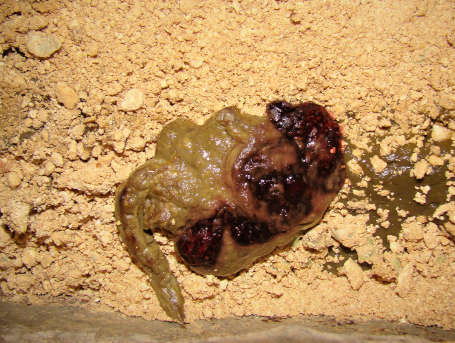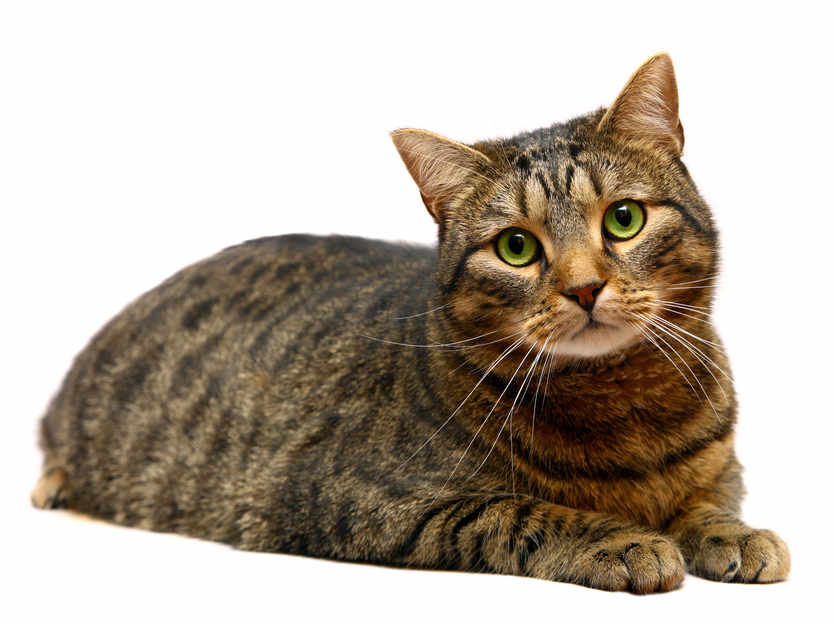As a veterinarian, I received several calls from clients who were concerned because their cat’s poop was slimy (looked like “jelly”) and had blood. Unless their kitty had other concerning signs like vomiting, diarrhea, depression, or anorexia, I let the owners know that we should schedule an exam, but it wasn’t an emergency situation.
In this article, we’ll review what bloody mucus or jelly looks like in cats, the top reasons, what you can do about it, and what your veterinarian will do to diagnose and treat the problem.
What does bloody mucus or jelly look like in cat poop?
Normal cat stools usually look like tootsie rolls and are firm and dark brown. When there’s blood in cat poop, it may be bright red or a dark, tarry color. Bloody mucus or jelly can come in many shapes and forms. The amount of blood can range from flecks or streaks to completely red stools. In other words, bloody mucus or jelly in cat’s poop comes in many different shapes and colors. Below is a picture showing an example:

Bright red blood usually comes from the colon or rectum and is known as hematochezia. If the blood is from the stomach or small intestines, it is dark brown or black in color due to digestion. This type is called melena. Excessive mucus in the stool will make it appear slimy or slippery.
Is bloody mucus or jelly in cat poop an emergency?
Usually, bloody mucus or jelly in your cat’s poop is not an emergency. Unless your cat has uncontrolled bleeding, is depressed, or has other concerning signs, you don’t have to rush your precious furbaby to the clinic. However, you should contact your veterinarian and schedule an exam as soon as possible. Bleeding or excess mucus may be a reaction to a food change, but it can also be a sign of an underlying disease that should be treated by a veterinarian as soon as possible.

Top reasons a cat poops bloody mucus/jelly
When cats poop bloody mucus or jelly, it may be a sign of something harmless, or it could be something that requires veterinary care. There are several top reasons for finding slimy, bloody poop in felines.
1. Inflammatory bowel disease
Inflammatory bowel disease (IBD) in cats is a chronic condition that occurs when the intestine and stomach lining experience inflammatory changes and grow thicker. As a result, the gastrointestinal tract is less effective in absorbing nutrients. It affects the entire digestive system and causes several symptoms in addition to bloody stools.
- Chronic diarrhea
- Vomiting
- Flatulence
- Going outside of the litter box
- Loss of appetite
- Weight loss
- Lethargy
There is no cure or prevention for IBD. Treatment for the condition depends on the symptoms and severity of the disease in your cat but may include:
- Dietary modifications
- Deworming
- Antibiotics
- Corticosteroids for inflammation
- Nutritional supplements including probiotics and B vitamins
- Immunosuppressants
2. Constipation
Cat feces tend to be firmer and drier than dog feces, and most cats drink less water than dogs. So, it’s not surprising for felines to suffer from constipation. There are various causes of constipation including dehydration, lack of exercise, trauma, or an impaction. When a cat is constipated he will produce very little or no feces. The poops are hard and dry but can include mucus and bright red blood from your cat’s straining to defecate.
To treat constipation in cats, your veterinarian may prescribe laxatives to loosen the stool. He’ll also recommend adding water to your cat’s food and gently encouraging your cat to exercise. View our favorite home treatments for cat constipation.
3. Infections
Infectious diseases from bacteria or viruses can trigger blood or mucus in the stool. In addtion, you may notice:
- Diarrhea
- Straining to defecate
- Vomiting
- Fever
- Loss of appetite
Cats with bacterial infections can be treated with antibiotics and anti-inflammatory medications. Your veterinarian may also recommend fasting your kitty for a meal followed by feeding a bland diet to soothe the digestive tract. View most common skin infections in cats.
4. Intestinal parasites

The most common parasites that can cause bloody diarrhea or mucus in cats are intestinal worms and protozoal parasites:
Worms: Roundworms and hookworms commonly affect cats. These intestinal parasites locate in the gastrointestinal tract and cause irritation. Signs of worms include:
- Diarrhea
- Swollen abdomen
- Dull hair coat
- malnutrition
- Weight loss
- Changes in appetite
Usually, intestinal worms can be effectively treated with the appropriate anthelmintic.
Protozoal parasites: Giardia or Coccidia are single-celled protozoal parasites that infected cats pass in their feces. Kittens and adult cats that are immune compromised or weakened by another condition are most susceptible to the disease. In addition to blood and mucus in the stool, common symptoms are:
- Diarrhea
- Vomiting
- Lethargy
- Weight loss
- Dehydration
- Loss of appetite
- Abdominal pain or distress
Protozoal parasites are usually effectively treated with the appropriate antibiotic. Because this is a transmissible disease, you should also treat the environment by disinfecting the litter box regularly and cleaning/sanitizing bedding and toys.
5. Pancreatitis
The pancreas produces enzymes that are normally activated in the small intestine and aid in digestion. However, if the enzymes become active prematurely, they start to digest the pancreas and trigger an inflammatory reaction. In cats, pancreatitis can occur spontaneously or be a secondary condition. Signs of pancreatitis are often nonspecific but can include:
- Lethargy
- Anorexia
- Vomiting in some cats
- Fever
- Diarrhea
- Abdominal pain
Usually, cats will require hospitalization and supportive care for 2-4 days. The treatment regimen for pancreatitis varies depending on the severity of the symptoms.
- IV fluids
- Pain medications
- Anti-inflammatory medications
- Antiemetics
- Withholding food and water for 24-48 hours to stop the production of pancreatic enzymes
- Antibiotics if a secondary infection is suspected
Cats with mild pancreatitis have a good prognosis if they receive early and aggressive treatment. However, some kitties are prone to recurrent bouts of pancreatitis. More severe cases have a guarded prognosis and may trigger onset of diabetes mellitus.
6. Diet
Sudden changes in your cat’s diet, a food sensitivity, or a dietary indiscretion can cause inflammation in the gut and diarrhea with blood or mucus. Other signs you may notice if your cat eat’s something that disagrees with her include:
- Straining to defecate
- More frequent poops
- Vomiting
- Loss of appetite
- Flatulence
Treatment for an inflamed gut includes resting the digestive tract by switching to a bland diet for a few days. If your kitty has a food sensitivity, your vet may try an elimination diet to identify and remove trigger ingredients. Other therapies may include anti-inflammatory drugs, anti-motility medications, and antibiotics if needed.
What you can do at home to help your cat
If your kitty has a mild digestive upset and isn’t showing other symptoms, you can try:
- A bland diet: putting her on a bland diet for a few days to rest the gastrointestinal system. Try boiled chicken, white fish, or a prescription diet for sensitive stomachs. You can also supplement your furbaby’s diet with probiotics.
- Prescription foods for sensitive stomachs: they contain hydrolyzed proteins that are easy on your cat’s system and single ingredients that are less likely to trigger allergies. Examples of veterinary-formulated diets include Hill’s Prescription Diet z/d cat food and Blue Buffalo Natural Veterinary Diet GI Gastrointestinal Support Cat Food.
- Probiotic supplements: probiotic supplements contain live microorganisms that help to promote healthy gut flora and normal digestion. When choosing a probiotic, check the label for active cultures. Some examples of cat probiotics include VetriScience Laboratories Probiotic Everyday for Cats and Pet Naturals Daily Probiotic for Cats.
When should you see your veterinarian?
When you notice blood or mucus in your cat’s poop, you should call your veterinarian and schedule an exam. While the stool changes may be due to a simple stomach upset, they may also be indicating an underlying condition that requires veterinary care. Usually, you can wait for an appointment and observe your cat at home. However, you should get your kitty to the doctor as soon as possible if you notice certain signs, including:
- Repeated vomiting
- Refusal to eat
- Hunched up abdomen
- Hissing or acting agitated/painful
- Depression
What can I expect when I take my cat to the vet?
When you take your cat in for an exam, bring a stool sample. The doctor will start by getting a history. Be prepared to tell him when you first noticed the blood or mucus in your cat’s poop and if there have been any recent changes in diet or routines at home.
Diagnosis
Based on the history, physical examination, and fecal examination your veterinarian may run additional diagnostic tests.
- x-rays/ultrasound
- Blood samples
- Urine samples
Treatment
Once your veterinarian diagnoses the underlying cause of the blood or mucus, he will treat your cat accordingly. Therapy may include:
- Supportive care such as IV fluids
- Anti-inflammatory medications
- Antibiotics
- Deworming
- Laxatives
- Fasting or a bland diet
- Dietary modifications
Prevention
Many of the causes of poop with blood or mucus are hard to prevent, but there are some things you can do to support your cat’s overall gastrointestinal health.
- Treat your kitty with preventative anthelmintic medications particularly if she spends time outside
- Keep your cat up-to-date on annual vaccinations to prevent infectious diseases
- Supplement the diet with probiotics
- Feed a quality diet with easily digestible ingredients
- Switch food gradually(over about 2 weeks) any time that you make dietary changes

